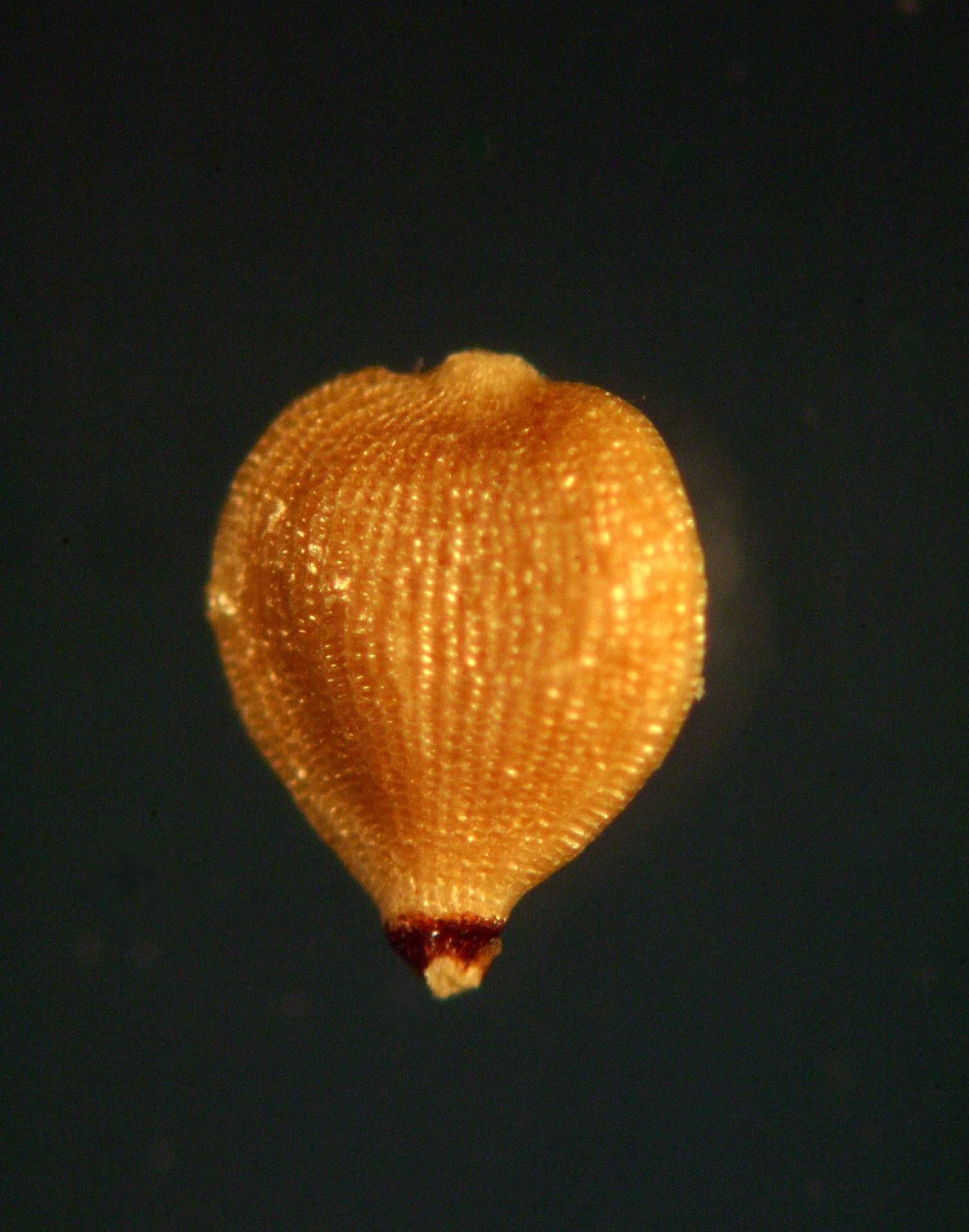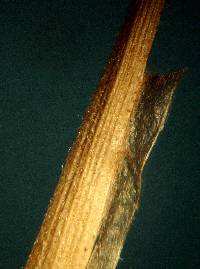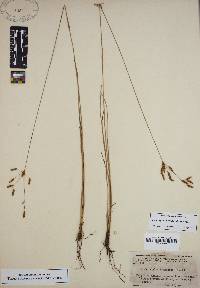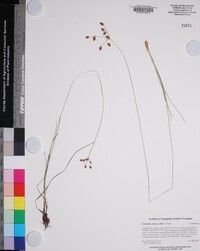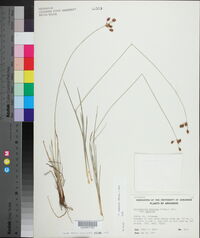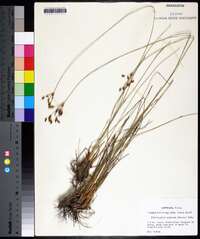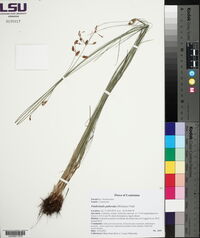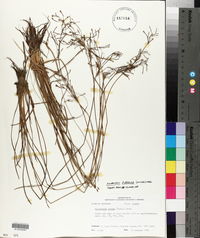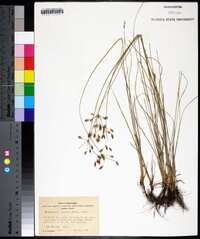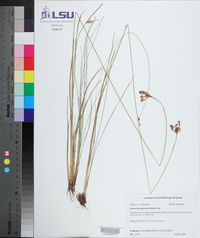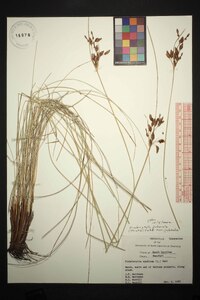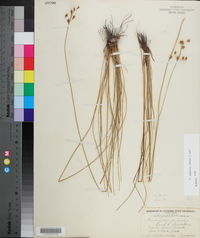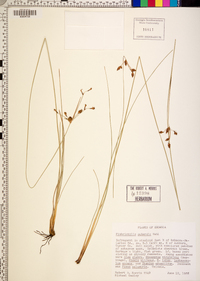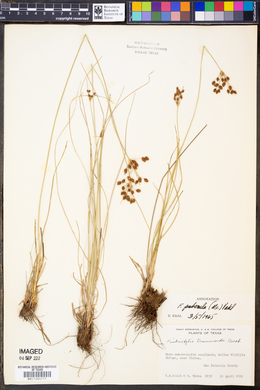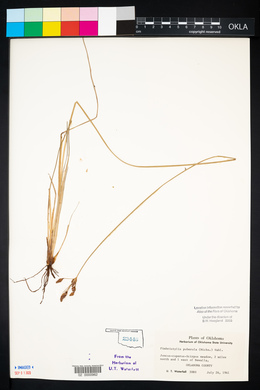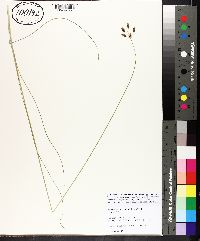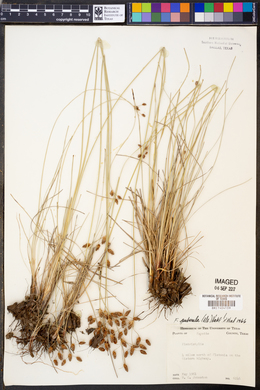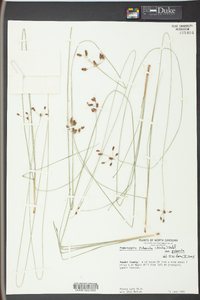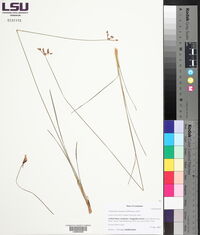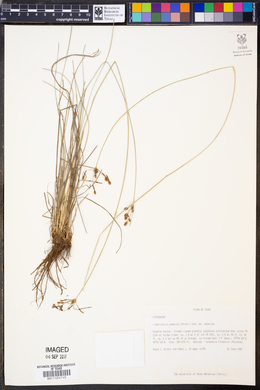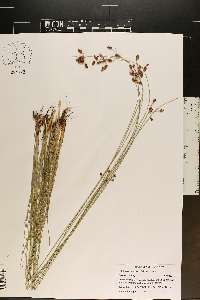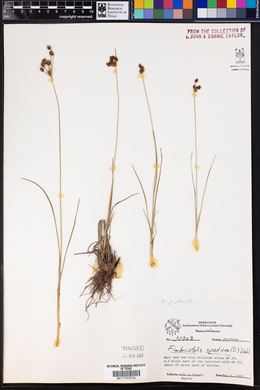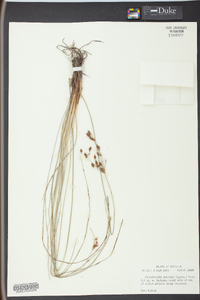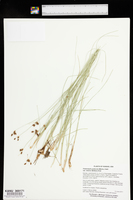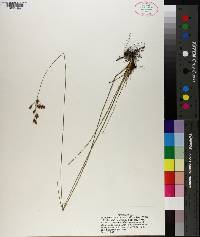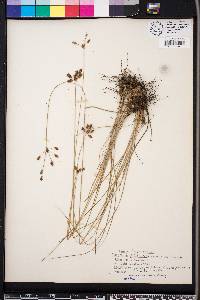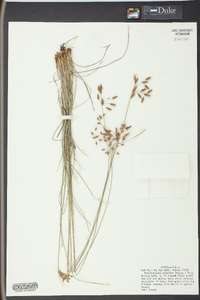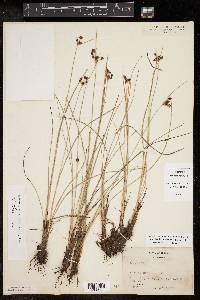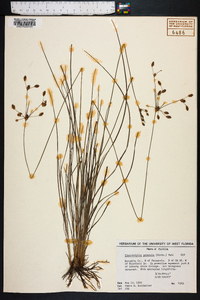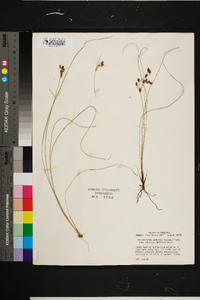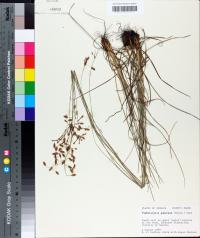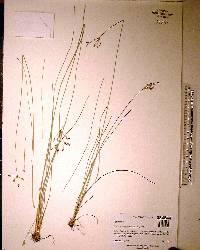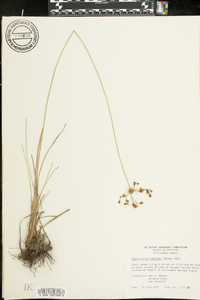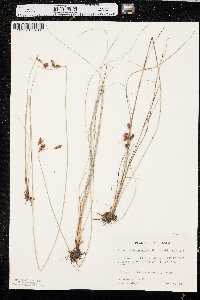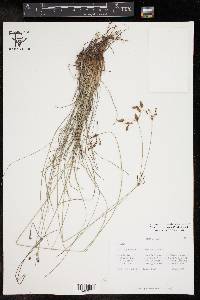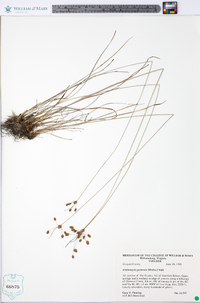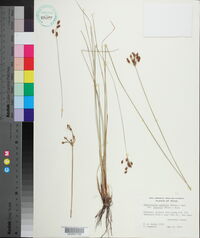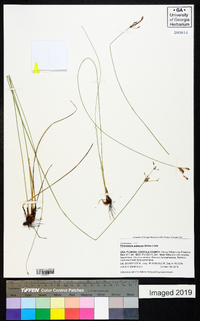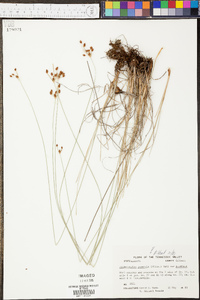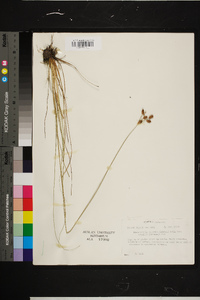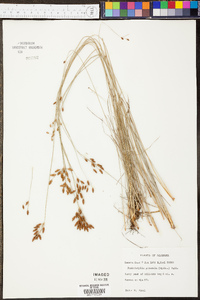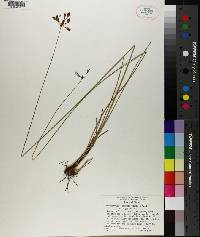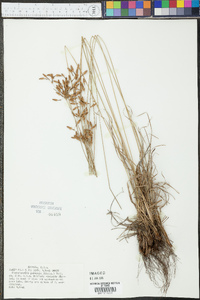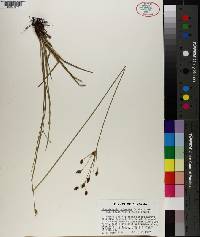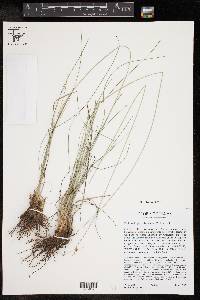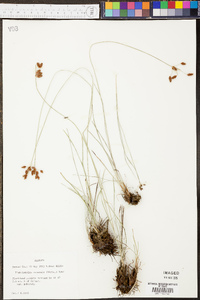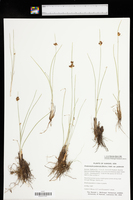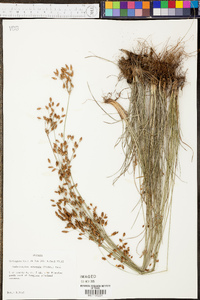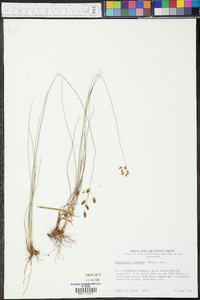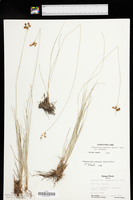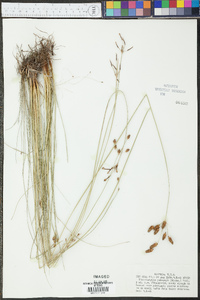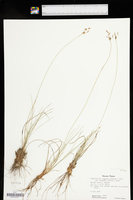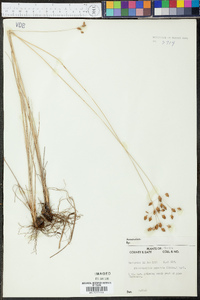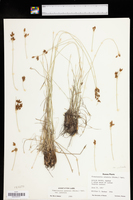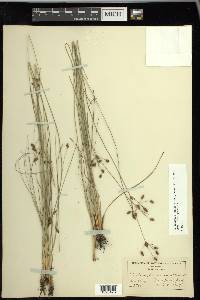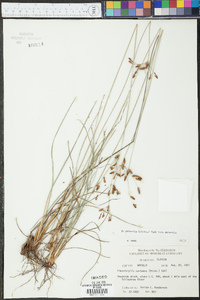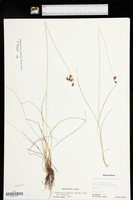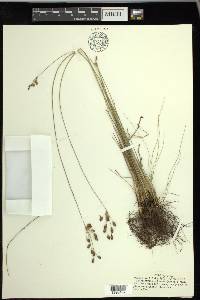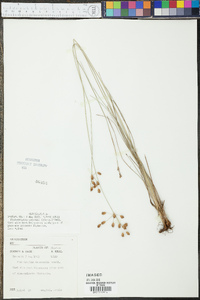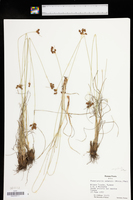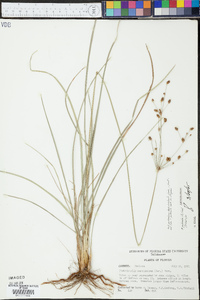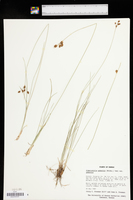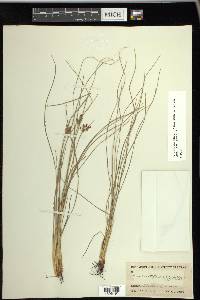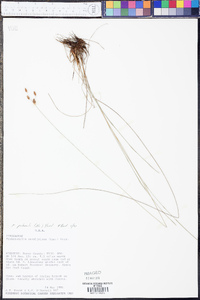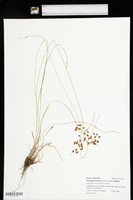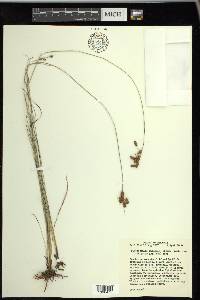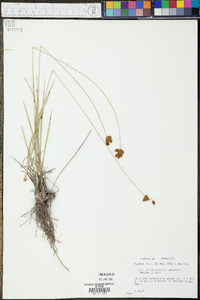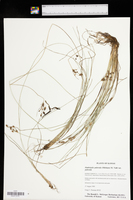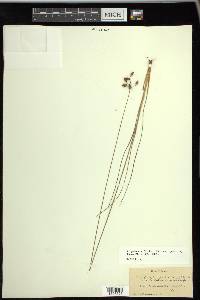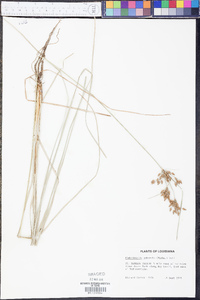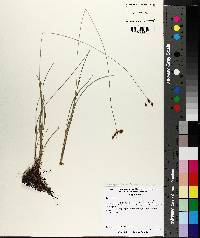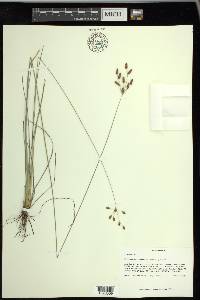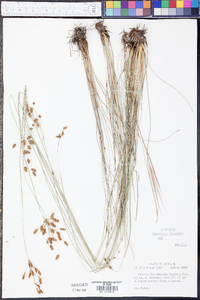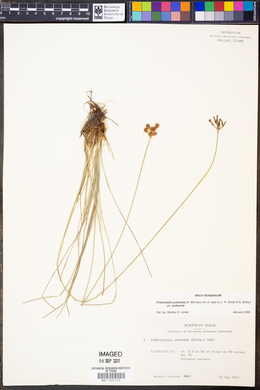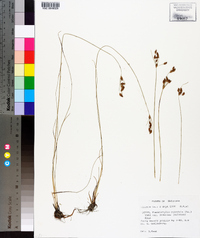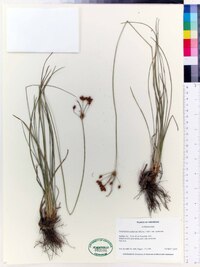
|
|
|
|
Family: Cyperaceae
Hairy Fimbry
[Fimbristylis spadicea var. puberula (Michx.) Chapm.] |
Plants perennial, mostly loosely cespitose, to 100 cm, bases swollen; rhizomes short, knotty, or scaly, slender, contorted. Culms sometimes solitary, narrowly linear, distally angular, glabrous. Leaves ascending, from 1/3 as long to equally as long as culms, glabrous to pubescent; sheaths apically ciliate; ligule essentially absent or (in rhizomatous individuals) present, complete or incomplete; blades narrowly linear, 1-2 mm wide, mostly strongly involute, scabrid-ciliate. Inflorescences: anthelae simple or compound, compact or diffuse, mostly broad, ascending-branching; scapes slender, wandlike, 1 mm thick; lower leafy involucral bracts exceeded by or exceeding panicle. Spikelets variously red-brown, broadly ovoid to lance-cylindric, 5-10 mm; fertile scales broadly ovate, obtuse or obtuse-angled, 2.5-3.5 mm, abaxially glabrous or variously puberulent, midrib excurrent as mucro. Flowers: stamens 3; styles 2-fid, flat, fimbriate. Achenes yellowish to dark brown, lenticular-obovoid, 1 mm, with 11-20 vertical lines of horizontally rectangular or isodiametric, distinct or indistinct pits. 2n = 20. Perennial herb with rhizomes, loosely tufted or culms sometimes solitary to 1 m tall Leaves: basal, ascending, shorter than or as long as culms, 1 - 2 mm wide, narrowly linear, parallel-veined, marginally rolled inward above, sometimes hairy, with a sheathing base that encloses the stem. Sheaths shorter than the blade, broadly margined, and opening at the top. Inflorescence: a terminal, simple or compound, dense or widely spreading anthela of spikelets subtended by leaf-like bracts (an anthela is a type of inflorescence which bears lateral branches that are longer than the main axis). Bracts shorter than or surpassing the inflorescence. Flowers: minute, subtended by a floral scale, lacking sepals and petals. Stamens three, exserted. Anthers 2 - 2.5 mm long. Pistil one. Style enlarged basally, fringed, two-cleft. Fruit: a one-seeded achene, yellowish to brown, to 1 mm long, swollen, reverse egg-shaped and biconvex, minutely cell-like and wrinkled in vertical rows. Seed with a thin, non-adherent wall. Culm: sometimes solitary, to 1 m long, slender, circular or broadly oval in cross-section, angled above, solid, variably hairy, growing above the leaves. Spikelets: reddish brown, 0.5 - 1 cm long, widely egg-shaped to cylindrically lance-shaped. Floral scales spirally arranged and overlapping, 2.5 - 3.5 mm long, widely egg-shaped or reverse egg-shaped, sometimes minutely hairy, with a midrib that extends past the apex into a tiny point. Lower spikelet scales non-flowering, larger than the fertile flower scales, and often bladed. Similar species: The similar Fimbristylis autumnalis differs by having three-cleft styles and three-angled achenes. Flowering: July to early August Habitat and ecology: Most common in flat sandy grasslands near Lake Michigan. It also has been found in a sandy wet prairie and in other sandy areas away from the lake. Occurence in the Chicago region: native Etymology: Fimbristylis comes from fimbria, meaning "a fringe," and stylus, meaning style, referring to the hairy-fringed style in the genuine species. Puberula means tiny-haired. Author: The Morton Arboretum Perennial from short, stout, knotty rhizomes; stems solitary or in small tufts, to 1 m, smooth, slender, terete or broadly oval in section; lvs smooth or often hairy, usually involute, ca 1 mm wide; ligule inconspicuous or wanting; longest invol bract usually much shorter than the infl; spikelets 5-10 mm, ellipsoid to lance-ovoid or ovoid, not very numerous, in a usually compound system of subumbellate cymes; scales ovate to obovate or reniform, usually smooth, minutely excurrent- mucronate; stamens 3; anthers 2-2.5 mm; style bifid, fimbriate from near the middle to the branch-point; achene lenticular, obovate, 1 mm, finely cellular-reticulate in vertical rows; 2n=20, 40. Meadows, prairie swales, savannas, and upper edges of marshes and bogs, not or scarcely maritime; s. U.S., n. mainly on the coastal plain irregularly to L.I., Pa., Mich., and Ill., more commonly to Mo. and Neb., and irregularly to Utah. Ours is var. puberula. West of our range this gives way to var. interior (Britton) Kral, with numerous more slender rhizomes and with the longest bract usually surpassing the infl. (F. interior) Gleason, Henry A. & Cronquist, Arthur J. 1991. Manual of vascular plants of northeastern United States and adjacent Canada. lxxv + 910 pp. ©The New York Botanical Garden. All rights reserved. Used by permission. |
This project was made possible in part by the Institute of Museum and Library Services [MG-70-19-0057-19].
Powered by Symbiota

